The Intel Broadwell Desktop Review: Core i7-5775C and Core i5-5675C Tested (Part 1)
by Ian Cutress on June 2, 2015 7:45 AM ESTProfessional Performance: Windows
Agisoft Photoscan – 2D to 3D Image Manipulation: link
Agisoft Photoscan creates 3D models from 2D images, a process which is very computationally expensive. The algorithm is split into four distinct phases, and different phases of the model reconstruction require either fast memory, fast IPC, more cores, or even OpenCL compute devices to hand. Agisoft supplied us with a special version of the software to script the process, where we take 50 images of a stately home and convert it into a medium quality model. This benchmark typically takes around 15-20 minutes on a high end PC on the CPU alone, with GPUs reducing the time.
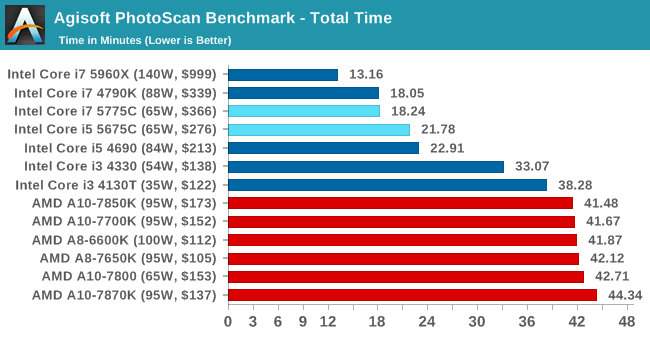
The presence of Crystal Well had a small effect on Photoscan, occurring mostly in the second phase of the calculation which is the one that also has an option to enable the GPU, indicating that memory bandwidth is an potential limitation in that segment.
Cinebench R15
Cinebench is a benchmark based around Cinema 4D, and is fairly well known among enthusiasts for stressing the CPU for a provided workload. Results are given as a score, where higher is better.
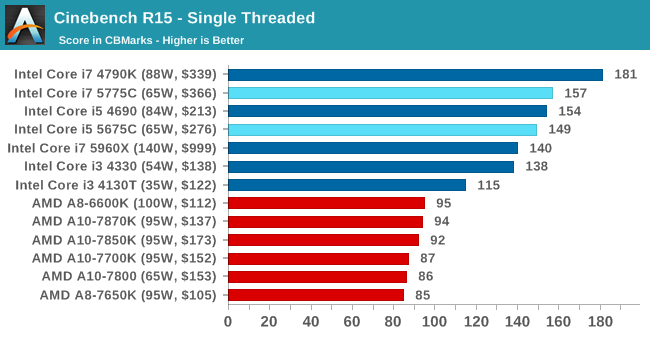
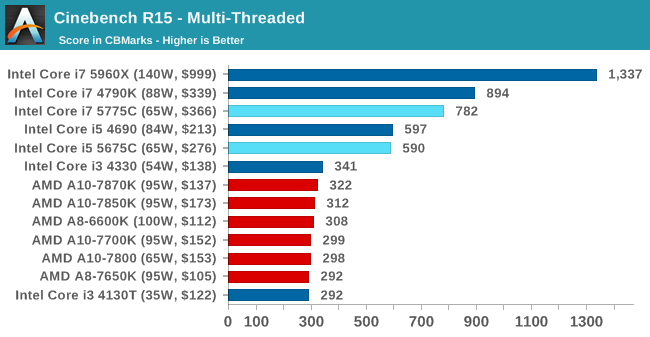
Cinebench is a historically CPU-limited benchmark, and the results show this again here. The fact that the 3.6GHz Broadwell-based i5-5675C performs so closely to the 3.9GHz Haswell-based i5-4690 is a promising sign here, as it means that despite being a mere "tick" in Intel's development efforts, there are tangible IPC increases on the desktop from Broadwell.
HandBrake v0.9.9: link
For HandBrake, we take two videos (a 2h20 640x266 DVD rip and a 10min double UHD 3840x4320 animation short) and convert them to x264 format in an MP4 container. Results are given in terms of the frames per second processed, and HandBrake uses as many threads as possible.
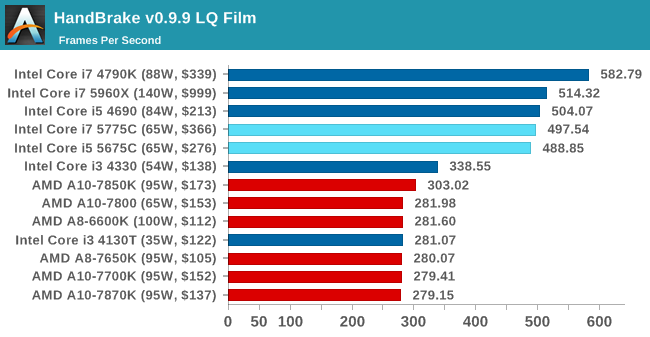

While no obvious improvement was seen in the low quality conversion, the double UHD conversion put the i7 above what was otherwise expected.
Hybrid x265
Hybrid is a new benchmark, where we take a 4K 1500 frame video and convert it into an x265 format without audio. Results are given in frames per second.
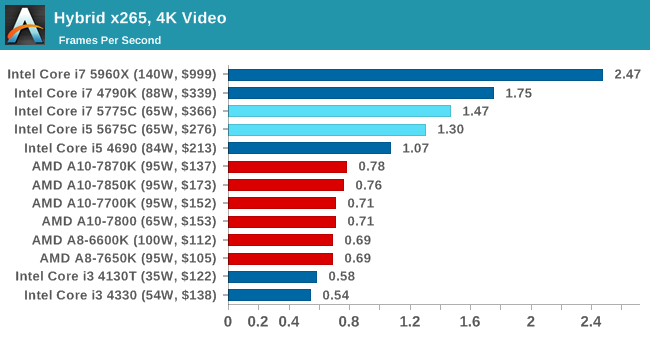
Unlike the Handbrake H.264 tests, the Hybrid x265 tests show a clear uptick in performance on the Broadwell processors. It is not fast enough to catch the i7-4790K and its 4.4GHz turbo clockspeed, but we see the i5-5675C shoot well past the i5-4690 despite the clockspeed deficit. Whether this is due to Broadwell architecture enhancements, Crystal Well acting as an L4 cache, or a combination of the two is difficult to determine, but the end result is substantial.










196 Comments
View All Comments
Peichen - Tuesday, June 2, 2015 - link
Intel is ridiculous in what way? You know Skylake is out in 2 months and that's why you are waiting for it. If you think Skylake isn't going to deliver why bother to wait? Intel haven't failed to deliver since Pentium M unlike AMD which is just one dropped ball after another. Sit tight and is gamers will have Skylake in no time. Today's release is for system builders that need a stopgap product, not us.Khenglish - Tuesday, June 2, 2015 - link
Why is the L3 cache only 6MB? Is 2MB disabled, or did intel cut the L3 size to reduce latencies since there is now an L4?Ryan Smith - Wednesday, June 3, 2015 - link
i5 processors typically have some of their L3 cache disabled.HollyDOL - Tuesday, June 2, 2015 - link
First time in years I am not sure what to think about this new cpu... Is it good? Is it delivering? On some things it quite rocks, on other seems like unfinished product/partial release... guess following months will tell...Valantar - Tuesday, June 2, 2015 - link
Just wondering: As previous Iris Pro vs. other integrated graphics reviews have shown Iris Pro to perform substantially worse at higher resolutions, are more tests above 720p coming in part 2? Or are you just going for whatever setting gets reasonably playable frame rates?sonicmerlin - Tuesday, June 2, 2015 - link
Why the frack didn't you test a midrange card at 720p so we can compare it to Iris Pro? They can't even do 30 fps at 1080p on most of the games you tested. What were you thinking?!bobhays - Tuesday, June 2, 2015 - link
On the low end gaming benchmarks for GRID, when benchmarking the r7 240 the minimum FPS for the A10-7700k is higher than the average FPS which doesn't make sense.bobhays - Tuesday, June 2, 2015 - link
Also wish they had tested dual graphics with a r7 240. The A10 ~ 130 + r7 240 ~ 70 = 200. That way we could compare a 200 dollar APU + GPU vs Intels new 200 dollar cpu'sOrphanageExplosion - Wednesday, June 3, 2015 - link
I've tried it with an A8 7650K and I can tell you that the frame-pacing is horrible, and the variance in frame-rate is stupendous. Crysis 3, 720p, low - 60fps looking in one direction, spin around on the spot and you're looking at 20-30fps looking in another direction.ryrynz - Wednesday, June 3, 2015 - link
Might wanna fix up that 128MB eDRAM comment Ian.